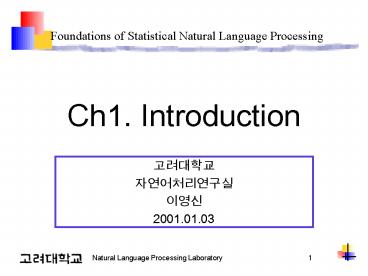Ch1' Introduction PowerPoint PPT Presentation
1 / 11
Title: Ch1' Introduction
1
Ch1. Introduction
Foundations of Statistical Natural Language
Processing
- ?????
- ????????
- ???
- 2001.01.03
2
Contents
- Rationalist and Empiricist Approaches to Language
- Motivation of Statistical NLP
- Dirty Hands
- Lexical resources
- Word counts
- Zipfs laws
- Collocations and Concordances
3
Rationalist and Empiricist Approaches to Language
(1/2)
- Rationalist Approach
- 19601985, Chomsky
- the key parts of language are innate
- ? Grammar rules are already exist in the
beginning. - Rule-based approach
- Categorical principles
- Saying that sentences either do or do not satisfy
the rule
4
Rationalist and Empiricist Approaches to Language
(2/2)
- Empiricist Approach
- Currently wide-spread
- organizing and generalizing the linguistic
knowledge from the sensory input - Corpus-based approach
- Assigning probabilities to linguistic events
- Saying which sentences are usual and unusual
- An empiricist approach to NLP
- Specifying an appropriate general language model
- Inducing the values of parameters by statistical
method, pattern recognition, and machine learning
5
Motivation of Statistical NLP (1/3)
- Conventionality
- Judge on whether it is the kind of thing that
people would say or whether it is semantically
anomalous - colorless green ideas sleep furiously
- non-native speakers often say something
ungrammatically, but we understand that - Explanation of Non-categorical phenomena
- Blending of parts of speech near
- Language change kind of and sort of
- Human cognition is probabilistic
- Language must therefore be probabilistic too
since it is an integral part of cognition
6
Motivation of Statistical NLP (2/3)
- Disambiguation
- Difficulty of disambiguation in symbolic NLP
system - There are many ambiguity in word sense, category,
syntactic structure and semantic scope - As sentences get longer and grammars get more
comprehensive, ambiguities lead to a terrible
multiplication of parses - Our company is training workers 3
- List the sales of the products produced in 1973
with the products produced in 1972 455 - The goal of maximizing coverage while minimizing
resultant ambiguity is fundamentally inconsistent - Manual rule creation and hand-tuning
- Time consuming to build
- Do not scale up well
- Produce a knowledge acquisition bottleneck
- Perform poorly
7
Motivation of Statistical NLP (3/3)
- Disambiguation (cont.)
- Majority of Statistical model in disambiguation
- Robust
- Behave gracefully in the presence of errors and
new data - Automatic learning
- Reduce the human effort in producing NLP system
8
Lexical Resources
Dirty Hands
- Corpus
- Collection of machine-readable texts
- Type
- Raw corpus vs. Tagged corpus
- Balanced corpus vs. unbalanced corpus
- Monolingual corpus vs. multilingual corpus
- Etc dictionary, thesaurus
- Institutions
- LDC (Linguistic Data Consortium)
- http//www.ldc.uppen.edu
- ELRA (European Language Resources Association)
- http//www.icp.grenet.fr/ELRA
9
Word Counts
Dirty Hands
- What is the most common words in the text
- Table 1.1
- It have important grammatical roles, and usually
referred to as function words - Word tokens and word types
- Word tokens
- Individual occurrences of words (the length of
text) - Word types
- The different words appear in the text
- Average frequency
- The ratio of tokens to types
- Table 1.2
- What makes frequency-based approaches to language
hard is that almost all words are rare
10
Zipfs Laws
Dirty Hands
- Zipfs law
- The frequency distribution of words
- f r k
- f the frequency of a word
- r the rank of a word
- k constant
- Table 1.3
- For most words our data about their use will be
exceedingly sparse - Mandelbrots formula
- f P / (r ?)-B
- f the frequency of a word
- r the rank of a word
- P, ?,B constant
- Other laws
- m ? f1/2
- m the number of meanings of a word
11
Collocations and Concordances
Dirty Hands
- Collocation
- Any turn of phrase or accepted usage that people
repeat - Include compounds, phrasal verbs, and idioms
- Needed to normalizing and filtering
- Important in machine translation and information
retrieval - Concordance
- Collecting information about patterns of
occurrence of words or phrases - Can be useful for purposes such as dictionaries
for learners of foreign languages, but for use in
guiding statistical parsers

